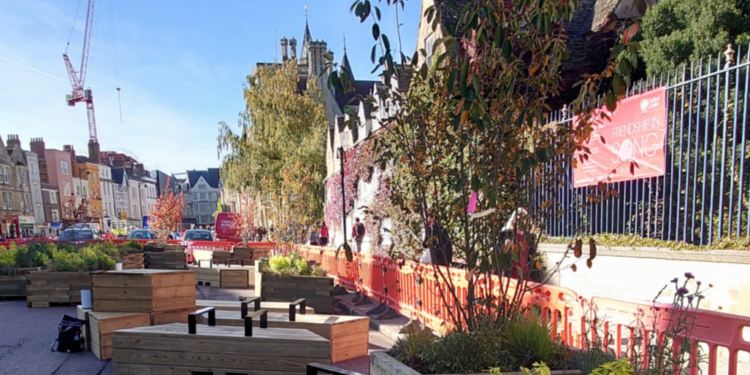For Augustus Pugin, the Gothic Revival in architecture – which he did much to unleash – had a very special and specific purpose. Pointed arches and gabled roofs were not just a design choice, but were riven with moral meaning. To Pugin, the neo-classical style of the previous century was to be despised above all else: its clean lines, and its clean facades, seemed to insist that the universe was rational and comprehensible to the human mind. To the brooding young Pugin, this was anathema. From Doric columns it was only a hop, step and a jump to the French Revolution and the Cult of the Supreme Being. The solution to secular hubris was to rebuild Britain in a confusion of gargoyles, tracery and flying buttresses; all of this would serve to re-enchant national life, and inspire a trembling awe for the universe and its mysteries.
The new bollard sitting areas, plonked in some of Britain’s main thoroughfares, proceed from a similar ethos. The first thing to note is that they are being raised in conscious defiance of something else. The new sitting area in Oxford’s Broad Street isn’t a paved-over section of its own, but is instead grafted straight onto the tarmac itself – this is not an attempt to build something, but to deface something else. You will notice also that there are hardly any benches, and those that do exist are indistinguishable from the bollards themselves. The purpose of this place isn’t for people to sit, but simply to obstruct the street for a moral purpose.

As with the Gothic style, the structure certainly doesn’t lack for ornament. The wooden bollards are irregular in shape and irregularly placed, forming a jagged line. Skin disease-like patches of solid yellow are strewn about the ground. The structure is further encrusted with a thicket of dry and scratchy plants, and a rats’ nest of bicycles. Whatever this is, it certainly does not obey the old modernist dictum that form should follow function. There is little of Le Corbusier to be found here, or even Norman Foster – New Labour’s court architect.
If these places have a moral purpose, then what is it? They are meant as a rebuke to apparent hubris; they declare that humans should not, or cannot, shape the world around them. Somehow, nature will always have its due – the weeds will always creep in, reclaiming all our achievements and bringing them low. It’s a kind of peevish version of the Babel myth. This is increasingly the tenor of British architecture, which insists on weighing down anything that may inch towards monumentalism or grandeur with haphazard clumps of grass and bramble.

But look at it this way. As a moral statement, it is an essentially despairing one. The architects of Oxford as a 15-minute city are not offering an alternative to modern industrial life, or even to car-centric life. No new system of trams or buses has been forthcoming, never mind a return to some kind of agrarian living. Instead, Net Zero architecture is content to nibble at the edges of modern life. Hating cars and the people who drive them, but unable to conceive of anything else, Oxford City Council can only petulantly obstruct by scattering objects in the way – almost literally a case of toys thrown out of the pram. A street isn’t a blank canvas; it is there to be used. To simply make a street worse and less functional, rather than abolishing it and building something else, is only demented.
The entire project of Net Zero follows a similar logic. Its predictions are cataclysmic, but its solutions are not. It doesn’t see a transformation of industrial society, only a gradual and forced winding down of living standards. It doesn’t offer a new way of life, but makes life harder for superstitious reasons. Net Zero proposes that just enough of industrial society be kept around in order to sustain the bureaucracy which is to carry this out.
By strangling one of the city’s main arteries, what the council declares is that Oxford – which by all economic logic should be Britain’s second city – is, in fact, a theme park. A Hogwarts theme park for tourists, kept in aspic as a medieval parody of itself. As Oxford is transformed from a scientific and industrial centre into a historical curiosity, the city will – I suspect – lose much of its charm. But this is likely to be lost on the planners themselves, who despair of urban life, and can only imagine city living as a collection of sham villages. We end up with all the mysticism of Pugin, but with none of the vision. Britain’s towns and cities are in the midst of another Gothic Revival – only this time without any buildings.











To join in with the discussion please make a donation to The Daily Sceptic.
Profanity and abuse will be removed and may lead to a permanent ban.
“When I was sixteen, I went to work for a newspaper in Hong Kong. It was a rag, but the editor taught me one important lesson. The key to a great story is not who, or what, or when, but why.“
I must admit it’s not entirely clear to me why it matters what gun was used.
Cover, Major, cover.
L Rons Hubbard is the usual apologist here for the US takeover of the Ukraine, its money laundering, bio-labs, its proxy war to try and weaken Russia, its imperialism.
Looking forward to L Rons next whingefest on the same, given that Russia has handed his deified NATO its ass.
I read somewhere that it was a regular 9mm poodleshooter reasonably expertly handled (dealt competently with a cycling problem).
The curious thing is the writing on the shell cases presumably designed to give a clue as to the why.
Health care is shall we say a contentious issue in the usa and the middle classes get well shafted by a deeply corrupt and unfair system riddled with government intervention (but I repeat myself).
A thoroughly sad story all round.
This appears to be some part of the motive:
‘A report released Oct. 17 by the Senate Homeland Security Committee’s investigative subcommittee scrutinizes some of the nation’s largest Medicare Advantage insurers for their use of prior authorization and high rates of denials for certain types of care. The subcommittee sought documents and information from the three largest MA insurance companies — UnitedHealthcare, Humana and CVS — and investigated their practice of “intentionally using prior authorization to boost profits by targeting costly yet critical stays in post-acute care facilities.”
The report found that between 2019 and 2022, UHC, Humana and CVS denied prior authorization requests for post-acute care at far higher rates than other types of care. In 2022, UHC and CVS denied prior authorization requests for post-acute care at approximately three times higher than the companies’ overall denial rates, while Humana’s prior authorization denial rate for post-acute care was more than 16 times higher than its overall denial rate. The report also found increases in post-acute care service requests subjected to prior authorization and denial rates for long-term acute care hospitals, among other findings.’
Apparently his company were one of the worst for refusing claims. I hope this makes other CEOs sit up and think about the business they are in.
To be clinical it’s also a pretty decent shot. Suppressors tend to make guns less accurate, the target is moving away from the shooter (in a video clip I’ve seen) and it’s dark, with no doubt a dose of anxiety about the escape route to add to the mix.
You live by the sword you die by the sword. You live by the invisible sword and you still die by the sword.